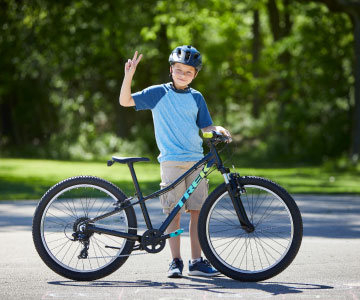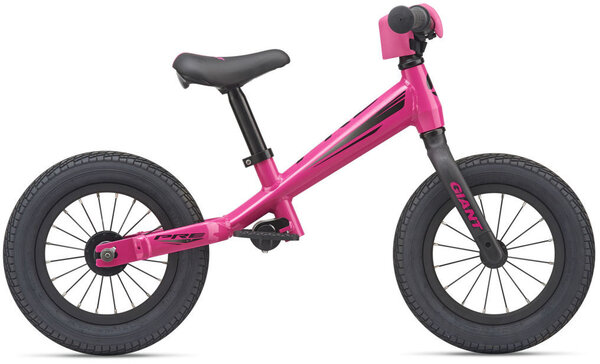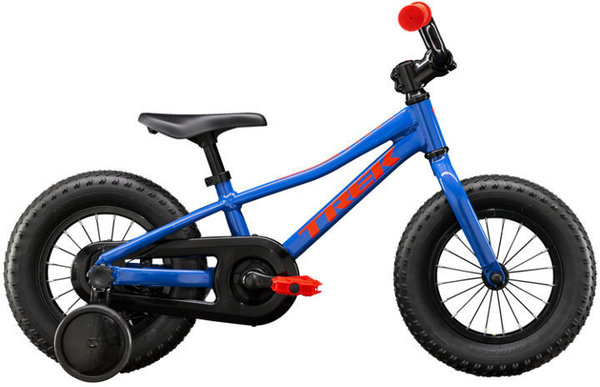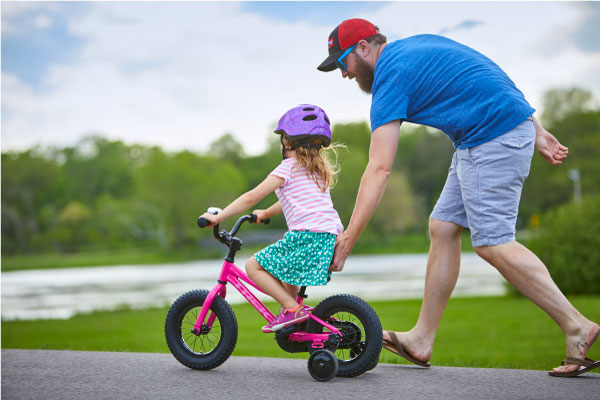Kids Bike Size Chart & Fit Guide
Buying a kids bike doesn't have to be tricky
We've helped countless parents find the right bikes for their children, so we know all about the common questions and concerns people have. How do you make sure the bike isn't too big? Too small? Too complicated or too simple? How do you decide between getting the right fit now and having a bike they can grow into?
To narrow down your search, use the kids bike size chart below and select the correct wheel size for your child. We’ve also included a breakdown of the most important measurements to consider when picking out a kids bike when they're in between sizes. Read on to learn about the different types of kids bike and which one is right for your child.
Kids bike size chart
Use this kids bicycle size chart to quickly find the right wheel size, but remember that it’s only a suggestion. We based the chart on average height and inseam for certain ages— some children are relatively tall for their age while some are shorter, the same goes for confidence. When in doubt, choose the wheel size according to leg inseam since it’s the most important proportion for bike fit.
What is the right size kids bike for my child?
Kids bikes are sized according to wheel size rather than frame size. The smallest balance bikes have 12” wheels while the largest kids bikes utilize 26” wheels.
To select the right size for your youngster, take an updated measurement of their height and compare it to the kids bike size chart posted below. Remember that the chart is just a starting point— use these additional metrics to confirm the correct size:

Leg inseam
Matching inseam length with the bike allows your child to pedal comfortably and efficiently. Also, they can easily dismount and safely stand over the bike while stopped. Use their leg inseam measurement to double-check the chart’s size suggestion.

Age
Age can be a good clue to the appropriate size. Our bike size chart for kids is based on an age range of average heights, but kids grow at different rates so it may not be accurate in every case.

Rider ability
Kids with more advanced bike skills can suit larger wheel sizes. Riders can “size up” early if they already have a good sense of balance and bike handling. Developing riders should stick to a smaller bike size until they build up a bit more confidence.
Kids bike sizing tips
Our #1 kids bike sizing tip
Choose a bike based on current fit as well as future growth. Kids should be able to ride their new bike right away— waiting too long to grow into it can cause a loss of interest. The bike should accommodate your child as they get taller, including the ability to raise the seat height and/or handlebar stem.
Start with their height
Start off by measuring your child’s height. Have them stand tall with their back against the wall, looking straight ahead. Use a pencil to mark the wall above their head.
Get their inseam measurement
Save some time and quickly take their leg inseam measurement, too. Standing in the same position, have them hold a book between their legs with the book’s spine meeting their crotch. The distance from top of the spine down to the floor is the leg inseam.
Matching leg inseam length to bike size ensures that your child can comfortably stand over the bike. Confirm there is about 1” or 2” of space between the top tube and their crotch while straddling the bike. This way, they can easily get on the bike or hop off the saddle in case of a sudden stop.
Take confidence into account
Consider your child’s riding ability to check if they can handle a larger wheel size. If they are close to the next bike size, they are probably ready to size up— even more so if they are already strong riders that feel confident making turns and stopping quickly.
Types of kids bikes
Depending on all the factors we mention above, you might be looking for one of a few different kids of kids bikes. Check out which one sounds like the best fit for your child. Here are the main styles of kids bikes:

Balance bikes
Balance bikes are the smallest kids bikes available and have no pedals so that kids can glide along with their feet on the ground.
These bikes typically use 12” wheels to keep kids close to the ground. Balance bikes are often the very first bikes a child rides, helping them develop the balance skills necessary for larger kids bikes.
When your child can glide for a long distance without touching the ground with their feet, they are ready to upgrade to a 12” model with pedals or a 14” bike.

Training wheel bikes
Some kids bike come with pre-installed training wheels and others have them added later. Training wheels help youngsters gain confidence pedaling while improving their sense of balance.
The extra wheels will keep them from tipping over so they don’t need to worry about falling. 12”, 14”, 16” and sometimes 20" kids bikes are typically compatible with training wheels.
Once your kiddo develops sufficient bike handling skills, you can remove the training wheels and when they outgrow the bike, it’s time to move up a size.

Typical kids bikes
Standard kids bikes with pedals range from 12” wheels up to 24” wheels.
Some models use a coaster brake that slows down when you pedal backwards while others have rim brakes with smaller, kid-friendly brake levers.
Larger bikes can have additional gears and sometimes front suspension.

Youth bikes
26”, 27.5” (also known as 650b) or 700c wheel sizes are technically adult sizes, but there are bikes specifically designed for older kids making the transition to adult bikes.
These “youth size” models feature geometry and other features built for young riders to continue developing their skills and can be slightly cheaper than a full-on adult bike.
These models are great options for tweens or teens as a first road bike or first mountain bike.
Let us help you find the right size kids bike

Kids love the thrill of going for a test ride and checking out different bikes and it's without a doubt the best way to ensure you're buying the right bike. If you are unsure about the right bike size for your child or just want to try out a few models, come on in to any of our three Alberta locations. Chat with our team of bike experts and enjoy a test ride to find the perfect kids bike.
Explore Our Top Kids Bike Brands
Kids bike sizing FAQs
How to measure the sizing of a kids bike
Unlike adult bikes, kids bike are sized according to the diameter of their wheels. Kids bikes range from having 12” wheels up to 26” wheels.
How can I tell the size of my child's bike?
Look on the sidewall of the bike tire for an embossed label of the wheel diameter. This wheel size, ranging from 12” to 26” is also the kids bike size.
How can you tell what size a bike is?
Kids bikes are sized based on wheel size rather than frame size. Determine the wheel diameter in inches by looking for the embossed label on the side of the tire.
What age is a 20 inch bike for?
A 20” bike will fit kids aged 5 to 8 years old. Children grow at different rates, so check out our children's bike sizing chart above for a more accurate recommendation.
What age is a 14 inch bike for?
Kids aged 3 or 4 years old will likely fit a 14” bike. Use your child’s height and inseam measurements to make sure they are riding the correct bike size.
Can you put 24-inch wheels on a 20 inch bike?
No, 24” wheels are too large to fit on a 20” bike frame.
Can a 7 year old ride a 20 inch bike?
A 20’ bike will probably be the correct size for a 7-year-old. However, kids grow at different rates, so compare their height and inseam to our helpful bicycle size chart for children for a second opinion. They may be ready for a 24” bike.
Can an 8 year old ride a 20 inch bike?
Yes, the recommended age for a 20” bike is between 5 and 8 years old. If your child is relatively tall, they may be ready to size up to a 24” bike.



